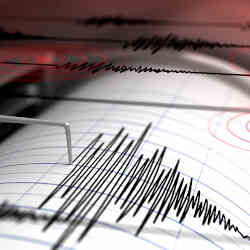
Few events on our planet are as complex as earthquakes. How, when and why they occur remains mostly a mystery, even with today's sophisticated instruments, sensors, and machines continuously monitoring and measuring seismic activity. "The vast number of variables and data points produce an extraordinarily complex picture," says Men-Andrin Meier, associate staff seismologist in the Seismological Laboratory of the California Institute of Technology (CalTech).
For decades, scientists have attempted to understand earthquakes using everything from satellite imagery to computer simulations, which have yielded modest and mixed results. Now scientists are turning to a new ally: artificial intelligence (AI), which is helping researchers better understand seismic events and develop early warning systems that can save lives and protect property.
"Machine learning and other forms of AI have emerged as valuable tools. They are advancing the science in a significant way," says Zachary Ross, an assistant professor of geophysics in the Division of Geological and Planetary Sciences at CalTech.
Finding Faults
The science surrounding earthquakes is extraordinarily complex. Unlike weather forecasting, which uses real-time data from satellites, sensors, and earth stations to track conditions as they occur, seismologists must rely on signals after an event. This data streams in from digital seismometers and broadband sensors on the ground. Measuring stress beneath the Earth's surface is next to impossible, because researchers don't have access to sensors buried deeply enough to measure underground forces.
Seismologists had largely given up on the idea of predicting earthquakes; at least, for the foreseeable future. However, the field is enjoying a renaissance thanks to machine learning and deep learning. Using connected sensors and algorithms, researchers are gaining insights into earthquake behavior, including how smaller swarms of temblors may or may not lead to a larger event. The researchers also are developing early alert systems that can protect property and lives. Says Meier, "We have gotten to the point where we don't have to choose between quantity and quality of the data."
These advances are, well, groundbreaking. Until a few years ago, seismologists mostly relied on basic data mining techniques developed in the 1980s to study quakes. They typically constructed simple algorithms that processed seismological data as a timed series of continuous ground motions.
Over the last few years, however, deep learning has produced far more advanced models. "Algorithms developed from deep learning systems now match or surpass what trained humans can do," Meier says.
At the heart of the data science challenge is separating "noise" from actual seismic events. Trucks, airplanes, garage doors, and even earthquakes from other parts of the world can trigger a false positive on sensors and digital seismographs. Fortunately, machine learning algorithms can analyze earthquake-generated compression waves (P waves) and shear waves (S waves) from multiple locations to determine whether a seismic event has occurred in any given place, and how serious it is. In a large urban area, "You have about 7 seconds max before you have to alert 20 million people," Ross says.
Angela Chung, project scientist for Earthquake Early Warning at the Berkeley Seismological Laboratory of the University of California, Berkeley (UC Berkeley), says machine learning excels at rapidly identifying and processing signals from seismic events. "It can distinguish between good and bad signals, and give us more confidence that an earthquake alert issued by our system is valid."
Putting Data into Motion
Data science is reshaping the field. One system, ShakeAlert, detects activity through a network of seismic sensors and, when the algorithm detects strong motion, it generates real-time alerts across the West Coast of the U.S. The technology, a collaboration among researchers at UC Berkeley, the California Institute of Technology, the California Office of Emergency Services, the U.S. Geological Service and several other entities, uses the U.S. Wireless Emergency Alerts (WEA) system and smartphone apps such as MyShake to warn recipients before the ground begins to shake.
The system provides recipients with anywhere from a couple of seconds to more than 10 seconds to take cover once the onset of an earthquake is detected. It also aids seismologists in forecasting aftershocks.
MyShake is also a research tool. The system relies on accelerometers built into smartphones to collect continuous live-motion data. Chung and other seismologists constantly study the data to further their knowledge of earthquake dynamics and learn whether a crowdsourced approach could deliver benefits. "While the individual sensors don't provide a high level of data resolution, a larger number of them dispersed into a network makes it possible to detect activity as it occurs," Chung says.
Says Meier, "Machine learning and deep learning are helping seismologists gain a much better understanding of the physics of earthquakes. For now, we're improving early detection, but the long-term goal is also to develop a deterministic model of how and why earthquakes occur."
Samuel Greengard is an author and journalist based in West Linn, OR, USA.



Join the Discussion (0)
Become a Member or Sign In to Post a Comment